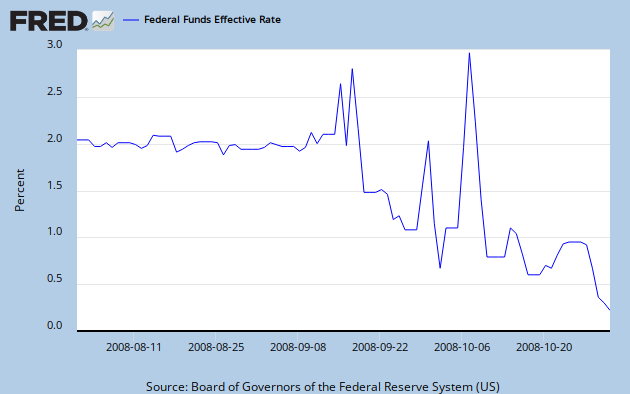Here is the explanation.
Bill McBride at Calculated Risk has been following the equity extraction data. Here is the March, 2014 update. Dr. James Kennedy, mentioned above, wrote that for technical reasons, the data set that he and Greenspan were using was no longer valid after 2008, and presented an alternate calculation method [link at the linked CR post.] McBride uses this alternate measure, calculated from the Fed's Flow of Funds data and the BEA supplement data on single family structure investment. Also linked at the CR article is a spread sheet with the two data sets. Graph 1, from CR, shows how the two data set compare.
Graph 1 - Equity Extractions - G-K Data vs CR Calculation.
I'm looking at the correlation between equity extractions and personal consumption expenditures during the housing bubble and collapse to support my claim. The method is to compare McBride's calculated data, which extends past the end of '08, and FRED Series PCE. Graph 2 shows Equity Extractions [blue, left scale] and the YoY dollar change in PCE [green, right scale] from 1991 through Q1, 2010, both in billions, quarterly data.
Graph 2 - Equity Extractions and PCE Change
The traces start rising together after the 1991 recession. There's a disconnect during the 2001 recession, when PCE takes a dive, but extractions continue to increase. From 2003 until the crash, they are close to being in lock-step; but from the peak, extractions fall farther and faster leading into the recession. One objection to my claim is that extractions decline a year earlier than PCE. We'll get to that.
Graph 3 shows a scatter plot of Year-over-year PCE dollar change vs equity extractions from Q1 2001 through Q3 2008
Graph 3 - PCE Dollar Change vs Equity Extractions - '01 to '08
The period from Q1, '01 through Q2, '03 is highlighted in red. During this time, PCE falls and levels off without a correlation to extractions. After mid '03, extractions and PCE rise together into the peak values highlighted in yellow, then fall together into the crash. R^2 for Q3 '03 through Q3 '08 is .75. This includes the blue and yellow points.
Graph 4 is a scatter plot of the Q1 '91 through Q1 '10 period. I've color coded data subsets representing different coherent realms.
Graph 4 - PCE Dollar Change vs Equity Extractions - '91 to '10
Starting from the 1991 recession in red, PCE increased into the cluster of purple dots representing Q1 '92 to Q1 '98. From Q2 '98 until Q1 '01 is another [less tight] cluster representing a greater change in PCE but only slightly higher equity extractions. This is the peak of the dot com bubble. Q2 '01 to Q2 '03 is again in red, the slide into and climb out of that recession. The blue dots, as in Graph 3, represent the period from Q3 '03 to Q3 '08 - the housing bubble peak and decline into the crash. The green dots are from Q3 '08 through Q1 '10, when everything collapsed and the correlation fell apart. The R^2 for all the data points except the green is .49. Eliminate the red dots as well, and it rises to .70. Take out the top 4 yellow dots, Q4 '99 to Q3 '00, and it rises further to .81.
This suggests that outside of recessions and the peak of the dot com bubble, which can be considered as distortions to a underlying trend, from 1992 on, changes in consumption expenditures were strongly correlated to mortgage equity extractions.
I used an ATM analogy for equity extraction, but there's a big difference. You can go to the ATM as often as you like, but extracting equity is an event that is unlikely to be repeated very often. So it's not out of the question to expect that the flow of equity dollars into consumption expenditures would be spread over several months - possibly a year or more.
I also looked at the correlation between extractions and the PCE dollar change 4 quarters later. This is shown in Graph 5.
Graph 5 - PCE Dollar Change vs Equity Extractions - '91 to '10
Color coordination, based on the PCE values, is the same as in Graph 4. The blue dots now make a more spiky array, but there is almost no loss in the coherence of the data sub sets. Only the green dots, now extended though Q1 '11, look substantially different. R^2 for the blue dots slips from .75 to .56, but for the entire data set [except the green dots] it increases slightly from .49 to .55.
Extraction data is seasonal, with local peaks in Q's 2 or 3, and valleys in Q's 4 or 1. This accounts for some of the data scatter. PCE dollar change data is smoother, with no consistent seasonal pattern. Graph 6 shows a scatter of 4Q averages of each variable, same color coding as graphs 4 and 5. Not including the recession-related red and green dots, R^2 is .75. Include the red dots and R^2 drops to .588.
Graph 6 - PCE Dollar Change vs Equity Extractions - '91 to '10 - 4 Q Avgs
It's now very easy to see the two variables rise and fall together from the time after the 2001 recession into the Great Recession.
I know correlation is not causation, but I have a coherent narrative that is completely consistent with the data. The behavior of the [blue dot] data from 2003 until deep into the collapse is striking, either with or without a 4 Q lag. Non-conforming data [other color dots] are explainable variances. I think the counter assertion that equity extractions had not a darned thing to do with the collapse into the great recession is not supported by real world data.














![[Most Recent Quotes from www.kitco.com]](http://www.kitconet.com/charts/metals/gold/tny_au_xx_usoz_4.gif)


